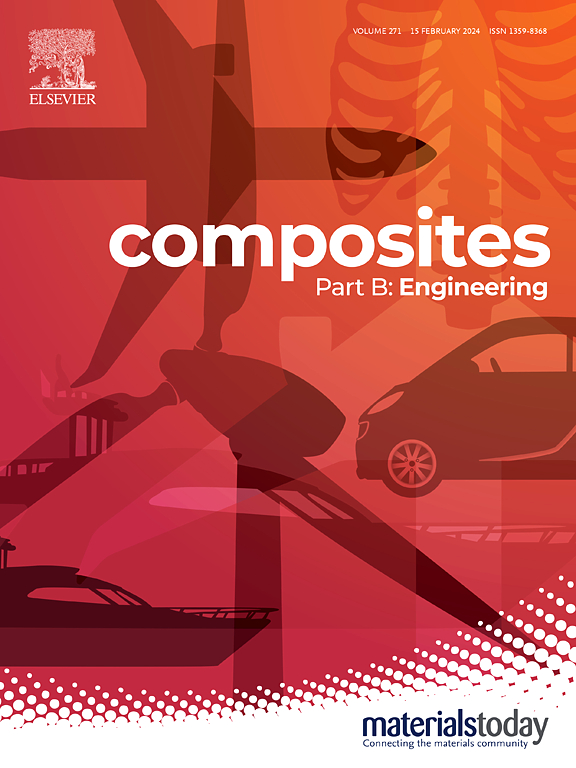Damage mechanism and residual tensile strength of CFRP laminates subjected to high-velocity sand erosion
IF 12.7
1区 材料科学
Q1 ENGINEERING, MULTIDISCIPLINARY
引用次数: 0
Abstract
Composite materials are used in the fan blades of advanced high bypass ratio aero-engines, and resistance to sand erosion is of significant importance for the design of these blades. This study investigates the sand erosion behavior of carbon fiber reinforced polymer (CFRP) composites under distinct impact velocities and erosion durations using rotary arm erosion testing apparatus. The damage evolution mechanism of CFRP laminates under sand erosion is quantitatively analyzed, while residual mechanical performance is also assessed. The experimental results show that continuous sand erosion typically results in erosion pits at the impact center and abrasion bands on the surface of CFRP laminates. It is found that as the erosion velocity increases, both the material strength and stiffness decrease significantly, with peak reductions of 64.7 % in tensile strength and 46.2 % in elastic modulus observed at the maximum tested velocity (200 m/s). An analytical model was developed to characterize the relationship between residual tensile strength and erosion damage parameters, which demonstrates good agreement with experimental results, with an average error below 7 %. The findings provide foundational experimental data on the erosion resistance and residual tensile properties of CFRP laminates, supporting the design and reliability assessment of erosion-resistant structures.

高速沙蚀作用下CFRP复合材料损伤机理及残余抗拉强度
先进的大涵道比航空发动机风扇叶片采用复合材料,其抗风蚀性能是设计风扇叶片的重要指标。采用旋臂冲蚀试验装置,研究了碳纤维增强聚合物(CFRP)复合材料在不同冲击速度和冲蚀时间下的冲蚀行为。定量分析了CFRP复合材料在沙蚀作用下的损伤演化机制,并对其残余力学性能进行了评价。试验结果表明,连续的沙蚀作用通常会导致CFRP复合材料冲击中心出现冲蚀坑和表面出现磨损带。结果表明,随着侵蚀速度的增加,材料的强度和刚度均显著降低,在最大侵蚀速度(200 m/s)下,材料的抗拉强度和弹性模量分别下降了64.7%和46.2%。建立了残余抗拉强度与侵蚀损伤参数关系的分析模型,与实验结果吻合较好,平均误差在7%以下。研究结果为CFRP复合材料的抗侵蚀性能和残余拉伸性能提供了基础实验数据,为抗侵蚀结构的设计和可靠性评估提供了依据。
本文章由计算机程序翻译,如有差异,请以英文原文为准。
求助全文
约1分钟内获得全文
求助全文
来源期刊

Composites Part B: Engineering
工程技术-材料科学:复合
CiteScore
24.40
自引率
11.50%
发文量
784
审稿时长
21 days
期刊介绍:
Composites Part B: Engineering is a journal that publishes impactful research of high quality on composite materials. This research is supported by fundamental mechanics and materials science and engineering approaches. The targeted research can cover a wide range of length scales, ranging from nano to micro and meso, and even to the full product and structure level. The journal specifically focuses on engineering applications that involve high performance composites. These applications can range from low volume and high cost to high volume and low cost composite development.
The main goal of the journal is to provide a platform for the prompt publication of original and high quality research. The emphasis is on design, development, modeling, validation, and manufacturing of engineering details and concepts. The journal welcomes both basic research papers and proposals for review articles. Authors are encouraged to address challenges across various application areas. These areas include, but are not limited to, aerospace, automotive, and other surface transportation. The journal also covers energy-related applications, with a focus on renewable energy. Other application areas include infrastructure, off-shore and maritime projects, health care technology, and recreational products.
 求助内容:
求助内容: 应助结果提醒方式:
应助结果提醒方式:


